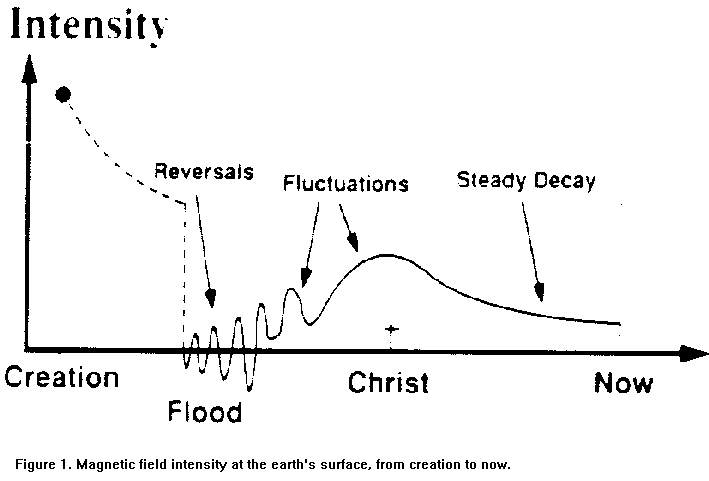
YEC Best Evidence 5: has the Earth's magnetic field always been decaying?
Posted at 10:00 on 06 November 2017
Posts in this series:
When I first saw the fifth claim on Answers in Genesis's list, I thought it was the most unconvincing of the lot. It takes direct observations of the decrease in the earth's magnetic field over the past 150 years and extrapolates them backwards exponentially, to show that just 20,000 years ago, you would have ended up with a magnetic field so strong that the heat released by the processes needed to generate it would boil the oceans.
What does the evidence say?
The most glaring problem with this argument is that there is no evidence whatsoever that the decay over the past 150 years is part of a long-term historical trend, let alone an exponential one. In fact, there is a lot of evidence that it isn't. Far from decreasing exponentially, the earth's magnetic field fluctuates chaotically and even reverses altogether from time to time. This is exactly what you would expect from a hot, roiling mass of molten metal, and that being the case, attempting to extrapolate backwards into the past, as this argument does, is just flat-out nonsense.
We can measure the historic strength of the earth's magnetic field by examining magnetic particles in ancient pottery of known ages, and going further back in time from ancient lava flows and the ocean floor. Such measurements from all around the world tell us that the earth's magnetic field reached a maximum about two thousand years ago, that its long term average for the past several hundred thousand years was about half of what it is today, and that it has reversed in polarity on numerous occasions throughout the earth's history, at random intervals varying between a few tens of thousands and many millions of years, with an average of three reversals per million years. (See e.g. Korte et al., 2011; Nilsson et al., 2014.)

Where does the earth's magnetic field come from anyway?
Despite the absurdity of this naive extrapolation, Andrew Snelling is asking a valid question here: namely, why does the Earth have a magnetic field at all? If the earth is billions of years old, why hasn't it decayed into oblivion? What is keeping it going? And why does it have the configuration that it does?

We know about the basic structure of the earth from seismic studies. It consists of a solid inner core, a liquid outer core, a mostly solid mantle, and a solid crust. The core is heated by mechanisms such as radioactive decay, latent heat of crystallisation as the inner core grows, and gravitational separation of heavy and light elements in the outer core. This heating gives rise to turbulent, convective currents, and these currents then generate a magnetic field which sets up a feedback loop making it somewhat self sustaining in strength and orientation.
This conventional model is called the dynamo model. It is described by a set of non-linear partial differential equations that are extremely complex and that behave chaotically, but it has good explanatory power, and computer models of the geodynamo have successfully explained aspects of the evidence such as past reversals.
Is the dynamo model broken?
The "Rescuing Devices" (sigh, here we go again...) section of the article gives a number of objections to the dynamo model. First of all, Dr Snelling claims that it contradicts some basic laws of physics. However, he doesn't say which laws of physics it contradicts.
It turns out that the "basic laws of physics" refers to Cowling's Theorem. It's a massive stretch to describe this as "basic" — Cowling's Theorem is complex and requires university-level mathematics to understand it. YEC literature available on the Internet makes no attempt to even explain what Cowling's theorem is, but merely relegates it to a footnote. However, this argument was outlined in a book called Origin and Destiny of the Earth's Magnetic Field by Thomas G Barnes.
This critique of Barnes's book points out that he wasn't getting his facts straight. Cowling's Theorem does not rule out the geodynamo altogether; instead, it merely places restrictions on what kinds of fields it can generate. In particular, it only says that an axially symmetric current can not sustain an axially symmetric dynamo. Since the currents in the earth's core have an asymmetry introduced by Coriolis forces from the earth's rotation, Cowling's Theorem is not the problem for the geodynamo that Barnes makes it out to be.
The second objection to the dynamo model is that it "fails to explain the modern, measured electric current in the seafloor." In support of this claim, we have a footnote referencing Lanzerotti et al (1985). It is not at all clear how this particular paper supports this particular assertion.
Computer simulations of the dynamo.
The third objection to the dynamo model is that it fails to explain the many geomagnetic reversals, "computer simulations notwithstanding."
In actual fact, computer simulations have managed to explain geomagnetic reversals. The simulations concerned were run by Gary Glatzmaier and Paul Roberts, who published their findings in Nature in 1995. Here is a video of the results of their simulation:
[youtube https://www.youtube.com/watch?v=SJDcyyY01p4&w=640&h=360]
In response to this, Snelling merely provides a reference in a footnote: D. Russell Humphreys, “Can Evolutionists Now Explain the Earth’s Magnetic Field?” Creation Research Society Quarterly 33, no. 3 (1996): 184–185. I can't find an online copy of this article. It's not listed in the abstracts for that edition of CRSQ, so I presume it's no more than a letter to the editor. Unfortunately the CRSQ is completely paywalled so I can not say what the reasoning is here, let alone whether or not it is correct.
In any case, "evolutionists" do not study the earth's magnetic field. They study biological evolution.
The young earth model.
The computer simulations of Glatzmaier and Roberts clearly falsify YEC claims that dynamo theory has been unsuccessful in explaining the Earth's magnetic field. However, it is worth saying a word or two about the YEC approach.
The YEC model was first outlined by Thomas G Barnes in 1971, who proposed that the magnetic field resulted from a freely decaying current in the core. However, this model has since been modified to try to account for geomagnetic reversals, and so they now propose that it was stirred at the start of Noah's Flood, giving rise to a rapid succession of geomagnetic reversals followed by large fluctuations up to the time of Christ, then a steady exponential decay over the past two thousand years. This is illustrated by this graph from the Institute for Creation Research:

In other words, having dismissed anything other than an exponential decay as a "rescuing device," they have had to ditch the exponential model themselves! If this isn't a "rescuing device" by their own standards, then what is?
In any case, there's also the question about whether this model is consistent with the evidence that we see today.
The number of reversals in the geological record runs into the hundreds. If these all took place during the Flood, they would have to be taking place at a rate of one a day or more. In such a model, it seems extremely unlikely that we would see any clean-cut reversals. Instead, we would see multiple poles popping up all over the place, and local magnetic fields would be changing faster than volcanic rocks could solidify. The magnetic remanence seen in cores taken from the ocean floor would be a complete jumble — if in fact there were any magnetic remanence to speak of at all.
In the Atlantic Ocean, deep sea cores from the ocean floor show a clear "banding" of magnetic reversals, and these are correlated on either side of the mid-oceanic ridge, as well as with drill core data from all over the world. We would not expect to see these correlations at all in a model where reversals happen on a daily basis.

The earth's magnetic field may be weakening at present, but this fact provides no support whatsoever for a young earth. The assumption of exponential decay on which this argument is build is demonstrably false and acknowledged by YEC scientists themselves to be inconsistent with the data. Elsasser's dynamo model may have had unresolved questions thirty years ago, but these have since been solved, and it has proven itself to be very successful in explaining the nature of the Earth's magnetic field. On the other hand, it is the YEC model which has serious shortcomings in explaining the data and which requires absurd "rescuing devices" in order to keep its head above the water.
Featured image credit: NASA Marshall Space Flight Center (via Flickr)